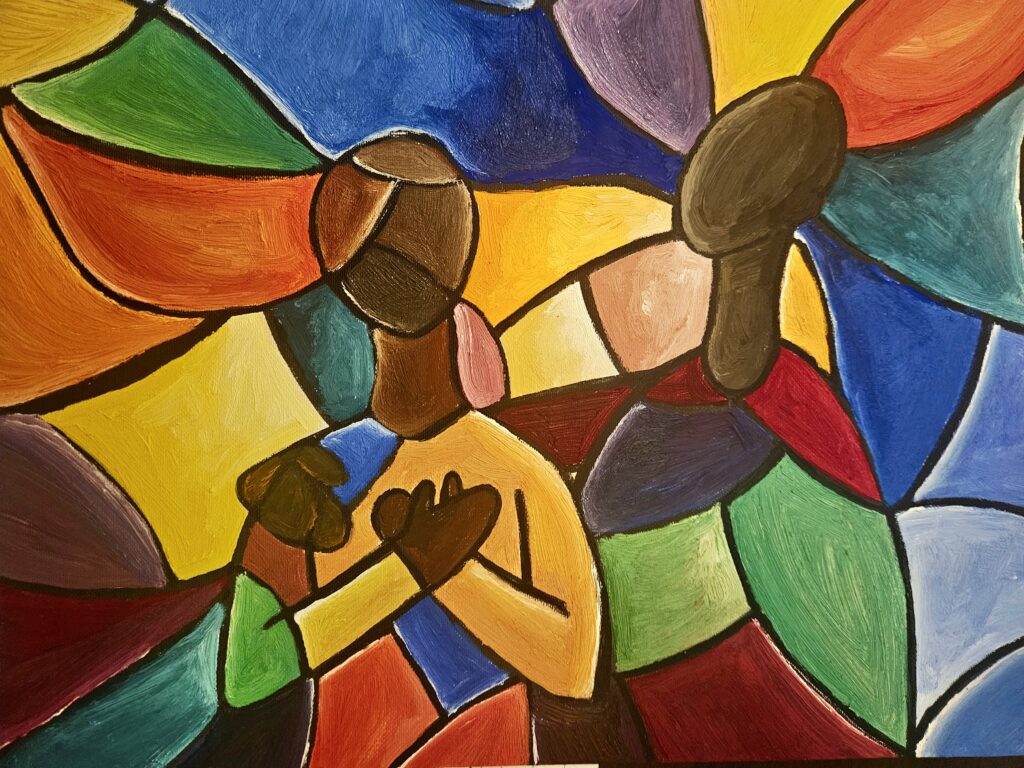Exploring Gratitude in Our Traditions
Expressing Gratitude through Art
All three Abrahamic traditions encourage us to recognize the blessings in our lives by expressing gratitude to God and to each other.
The collection below, curated by ICJS, brings together artists from each tradition to reflect on gratitude through their work. Each piece is paired with a line of scripture and a short overview of the concept of gratitude in each tradition.
Through this collection, we invite you to pause, to notice the good, and to consider opportunities to express gratitude in your daily life.
Islam
“Remember Me; I will remember you. And thank Me, and never be ungrateful.”
–Qur’an 2:152

Title: “So, Remember Me”
Medium: High Flow Acrylic, Spray Paint on Canvas
Size: 24 x 36 inches Canvas
2023
In Islam, God is known as the Most Generous (al-Karim) and the Most Appreciative One (al-Shakur). Out of His expansive compassion (al-Rahman), God cares for all creation as the Qur’an notes: “If you tried to count God’s blessings, you could never take them all in: He is truly most forgiving and most merciful.” Everything that we enjoy—the resources of the earth, our physical health, skills, families and wealth—are sacred bounties calling us to remember the ultimate Giver.
God loves those who express thankfulness to Him by sharing generously with others. In doing so, the believer cultivates greater closeness to God. Gratitude is part of the spiritual DNA of being a true believer as the Qur’an reminds us,” You will never achieve true piety until you give out of what you love. And whatever you give is certainly well known to God.”
This is the reason why Prophet Muhammad shared the little he had. His example was marked by an outlook of abundance as expressed in one of his famous narration, “The food of one person is enough for two, the food of two is enough for four, and the food of four is enough for eight.”
By Zeyneb Sayilgan, Ph.D., ICJS Muslim scholar
About the Artist

Nadia Janjua is a Visual Artist and founder of the creative business, NADIA J Art. She is also an Art Educator teaching at various Islamic schools based in MD, as well as independent and community programs. She is a currently the Middle School Visual Art & Design teacher at a private IB School in Elkridge, Maryland called Tarbiyah Academy. She holds a B.A. in Fine Arts from the George Washington University, and a Masters in Architecture from the New Jersey Institute of Technology.
Artist Statement:
“In all of my creative work, I am committed to narrating my inner truth and reflections through expressions of colors, texture, and text. I am drawn to the abstraction of concepts and moments, and thrive on the multiple interpretations that human experience brings to it. My art has been my source of healing, and in the process of creating it, I am essentially searching for the truest reflection and understanding my soul has ever experienced. Paintings often feel like they reveal themselves onto my canvas, and somehow I always seem to discover myself in them.”
See more of Janjua’s work on her website.
Christianity
“I do not cease to give thanks for you as I remember you in my prayers.”
–Ephesians 1:16

Title: “Grateful Hearts”
Medium: Oil paint
2025
In the New Testament scriptures, followers of Jesus Christ are repeatedly encouraged to cultivate a spirit of gratitude as both an intrinsic heart posture (Colossians 3:15) and a spiritual practice (Ephesians 5:20). For Christians, this thankfulness emerges from experiencing God’s profound love through the life, death, and resurrection of Jesus Christ and recognizing God as the ultimate provider of all blessings (James 1:17).
Christians demonstrate this gratitude both individually and communally through various expressions including offering prayers of thanksgiving, singing hymns of praise, giving generously, and serving others. A tradition within the African American Christian community is “testifying,” where individuals express gratitude by sharing personal stories of God’s goodness in their daily lives. This practice strengthens the community’s collective sense of thankfulness as they bear witness to each other’s experiences. The scriptures emphasize that this thankful perspective should permeate all aspects of life. “Whatever you do in word or deed, do everything in the name of the Lord Jesus, giving thanks through Him to God the Creator.” (Colossians 3:17).
Alisha Wimbush, Th.D., ICJS program director for religious leaders
About the Artist

Alisha Wimbush, Th.D., is passionate about building bridges across diverse communities and fostering meaningful relationships. As Program Director for Religious Leaders, she oversees ICJS programming for clergy, chaplains, and spiritual caregivers. Under her leadership, ICJS launched its chaplain outreach initiative following a statewide survey—conducted in partnership with the Chaplaincy Innovation Lab—that identified chaplains as an underserved sector. She also leads Common Ground: Clergy | Conversation | Connections, a statewide program that brings together religiously diverse clergy to build lasting relationships through quarterly conversations over the span of a year.
Artist Statement:
“Grateful Hearts is inspired by the words of the American Trappist monk, mystic, and theologian, Thomas Merton:
“’To be grateful is to recognize the Love of God in everything He has given us— and He has given us everything. Every breath we draw is a gift of His love, every moment of existence is a grace, for it brings with it immense graces from Him.’
“In this season of my life and moment in history, I am particularly grateful for the gift of community. One community that has been foundational in my own spiritual journey and is represented in this painting’s stained glass motif is the Black Church. The African American churches I belonged to through the years taught me the values of interdependence, justice, service, faith, and hospitality.”
Judaism
“Who is rich? One who rejoices in their own portion.”
–Pirkei Avot 4:1

Title: Who Is Rich?
Medium: Mixed media illustration
2025
All streams of Judaism emphasize gratitude (to both G-d and to other people) as one of the most essential middot (Jewish values). The concept of hakarat hatov (הַכָּרָת הַטּוֹב), or “recognizing the good,” calls us to notice and appreciate the blessings in our lives, even in times of difficulty.
Gratitude also lies at the heart of Jewish daily prayer. Upon waking, Jews traditionally recite Modeh Ani (מוֹדֶה אֲנִי), or “Thankful am I,” expressing thanks to G-d for the gift of life restored for another day. Throughout the day, traditional Jewish practice commands 100 brachot (blessings), each one a moment of gratitude for food, natural beauty, and even ordinary routines such as washing one’s hands.
Importantly, Judaism teaches that prayer is not primarily meant to influence G-d, but to transform the person who prays: to cultivate awareness, deepen gratitude, and sanctify the everyday. In this way, giving thanks becomes a spiritual practice that helps us more fully appreciate the abundance already present in our lives—family, friends, food, shelter, and more.
By Jessica Briggs, ICJS development manager
About the Artist

Julie Wohl is a Jewish educator and working artist. She is the co-creator and illustrator of “Siddur Mah Tov, a Family Shabbat Prayer Book”, and author of “Make, Create, Celebrate! a Jewish Holiday Art Journal”, both published by Behrman House. Julie is the Director of Congregational Learning at Baltimore Hebrew Congregation where she combines her love of teaching, Judaism and the arts to create a home for Jewish learning that is creative, joyful and often surprising. She and her husband Josh Wohl, are the proud parents of two teenagers and a cat named Rainbow.
Artist Statement:
Julie Wohl’s mixed media fine art pieces are influenced by Jewish tradition, texts, and the natural world. Whether in the creation of a mixed media soft sculpture, a bright painting or a piece of furniture, collectors have learned they can recognize Julie’s work by its flowing natural shapes, strong lines and layers of texture and color.
See more of Wohl’s work on her website.